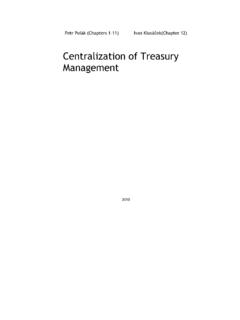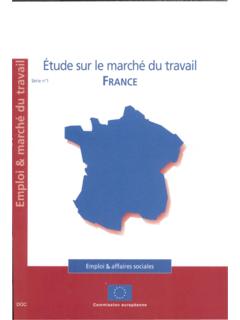Transcription of Theory and Practice of Regional Integration
1 Robert Schuman The Jean Monnet Chair Miami-Florida European Union Center of Excellence Theory and Practice of Regional Integration Finn Laursen Jean Monnet/Robert Schuman Paper SeriesVol. 8 No. 3 February 2008 The Jean Monnet/Robert Schuman Paper Series Published with the support of the EU Commission. The Jean Monnet/Robert Schuman Paper Series is produced by the Jean Monnet Chair of the University of Miami, in cooperation with the Miami-Florida European Union Center of Excellence, a partnership with Florida International University (FIU). These monographic papers analyze ongoing developments within the European Union as well as recent trends which influence the EU s relationship with the rest of the world.
2 Broad themes include, but are not limited to: EU Enlargement The Evolution of the Constitutional Process The EU as a Global Player Comparative Regionalisms The Trans-Atlantic Agenda EU-Latin American Relations Economic issues Governance The EU and its Citizens EU Law As the process of European Integration evolves further, the Jean Monnet/Robert Schuman Papers is intended to provide current analyses on a wide range of issues relevant to the EU. The overall purpose of the monographic papers is to contribute to a better understanding of the unique nature of the EU and the significance of its role in the world. Miami - Florida European Union Center Jean Monnet Chair Staff University of Miami Joaqu n Roy (Director) 1000 Memorial Drive Astrid Boening (Associate Director) 101 Ferr Building Mar a Lorca (Associate Editor) Coral Gables, FL 33124-2231 Shannon Gibson (Assistant Editor) Phone: 305-284-3266 Remi Piet (Research Assistant) Fax: (305) 284 4406 Maxime Larive (Research Assistant) Web.
3 Florida International University Elisabeth Prugl (FIU, Co-Director) Inter-American Jean Monnet Editorial Board Carlos Hakansson, Universidad de Piura, Per Finn Laursen, Dalhousie University, Halifax, Canada Michel Levi-Coral, Universidad Andina Sim n Bol var, Quito, Ecuador Jos Luis Mart nez-Estay Universidad de los Andes, Santiago de Chile, Chile F lix Pe a, Universidad Nacional de Tres de Febrero, Buenos Aires, Argentina Stephan Sberro, Instituto Tecnol gico Aut nomo de M xico Eric Tremolada, Universidad del Externado de Colombia, Bogot , Colombia The Jean Monnet Chair 2 Miami-Florida European Union Center of Excellence Theory and Practice of Regional Integration Finn Laursen Introduction In this paper I shall briefly outline the classical theories of Integration , especially neofunctionalism.
4 Which dominated the debate about European Integration from the very beginning in the 1950s until the early 1990s. Next I want to outline what I consider the most important contribution to Integration Theory in the last 10-15 years, namely Andrew Moravcsik s liberal intergovernmentalism. Then I will look at some of the most important critiques of liberal intergovernmentalism, especially public choice institutionalism and sociological institutionalism. I will finish with a brief case study, asking what we can learn in Theory and Practice from the rise and fall of the Constitutional Treaty. Classical theories1 Theories of Integration have mainly been developed to explain European Integration . Europe was the region of the world, where Regional Integration started in the early 1950s with the European Coal and Steel Community (ECSC) in 1952.
5 Ernest Haas theorized this experience in The Uniting of Europe (1958). The main theoretical contribution was the concept of spill-over. Later Lindberg used this concept to study the early years of the European Economic Community (EEC), which started its existence in 1958 (Lindberg, 1963). These early theories are usually referred to as neo-functionalist theories. There were some efforts to apply these neo-functionalist theories to Integration in other parts of the world, especially in Latin America (Haas, 1961; Haas and Schmitter, 1964; Haas, 1967). The Integration process in Europe experienced a crisis in the mid-1960, when General de Gaulle instructed his ministers not to take part in meetings of the EEC Council. In the Luxembourg compromise in January 1966 the then six members of the European Communities (EC) agreed to disagree.
6 The French insisted that decisions by a qualified majority vote (QMV) could not take place, when a Member State opposed a decision because of important national interests. Some neo-functionalists tried to modify the Theory to take account of the events in Europe in the mid-60s. This included Lindberg and Scheingold in Europe s Would-Be Polity (1970). But many students of European Integration now stressed the logic of diversity and the more intergovernmental aspects of the EC ( Hoffmann, 1965, P. Taylor, 1983). Later in the 1990s Andrew Moravcsik developed liberal intergovernmentalism to explain the process of Integration in Europe, suggesting the combination of a liberal Theory to explain national preference formation and an intergovernmental Theory of interstate bargaining to explain substantive outcomes (Moravcsik, 1991, 1993).
7 In his book The Choice for Europe he added a third Paper prepared for presentation at the European Union Centre, University of Miami, Coral Gables, Florida, 25 February 2008. Canada Research Chair and ad personam Jean Monnet Chair in EU Studies Department of Political Science and the EU Centre of Excellence (EUCE) Dalhousie University, Halifax, NS, Canada ( ) 1 This section relies upon Laursen 2003. 3stage, institutional choice, where pooling and delegation of sovereignty was seen as a way to create credible commitments (Moravcsik, 1998). During the 1990s, in parallel with the IR debate concerning rationalist approaches vs. social constructivist approaches, it was also claimed that we need a social constructivist approach to understand European Integration ( Checkel, 1999; Marcussen et al.)
8 , 1999). When early theories of Integration were developed there was much discussion in the literature on how to define the concept. It was for instance discussed whether Integration refers to a process or to an end product. Of course the two can be combined. Integration could then be defined as a process that leads to a certain state of affairs. Karl Deutsch, for instance, defined Integration as the attainment, within a territory, of a sense of community and of institutions and practices strong enough and widespread enough to assure, for a long time, dependable expectations of peaceful change among its population. When a group of people or states have been integrated this way they constitute a security community. Amalgamation , on the other hand, was used by Deutsch and his collaborators to refer to the formal merger of two or more previously independent units into a single larger unit, with some type of common government (Karl W.
9 Deutsch et al., 1957: 5-6). Early efforts to study Regional Integration , as mentioned, mainly concentrated on the European Coal and Steel Community (ECSC) and the European Economic Community (EEC). In Ernst Haas's classical study of the ECSC, The Uniting of Europe, Integration was defined as .. the process whereby political actors in several distinct national settings are persuaded to shift their loyalties, expectation and political activities to a new center whose institutions possess or demand jurisdiction over the pre-existing national states (Haas, 1958: 16). In Leon Lindberg's study of the early EEC, The Political Dynamics of European Economic Integration , Integration was defined without reference to an end point: .. political Integration is (1) the process whereby nations forgo the desire and ability to conduct foreign and key domestic policies independently of each other, seeking instead to make joint decisions or to delegate the decision-making process to new central organs; and (2) the process whereby political actors in several distinct settings are persuaded to shift their expectations and political activities to a new center (Lindberg, 1963: 6).
10 Lindberg considered his own concept of Integration more cautious than that of Haas. Central to it was the development of devices and processes for arriving at collective decisions by means other than autonomous action by national governments (Ibid.: 5). Some concepts of Integration applied in studies of the European Communities (EC) may be too specific if we want to conduct comparative studies. Clearly, the process of European Integration within the EC has gone further than Integration in other Regional settings. A relatively loose definition may be better for comparative studies. However, it seems fair to say that collective decision-making is an important aspect of all Regional Integration efforts. This collective decision-making can cover a varying number of functional areas (scope). The decision-making process can be more or less efficient and the common institutions established can be more or less adequate (institutional capacity).











